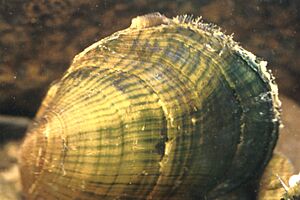Oyster mussel facts for kids
Quick facts for kids Oyster mussel |
|
|---|---|
 |
|
| Conservation status | |
| Scientific classification | |
| Genus: |
Epioblasma
|
| Species: |
capsaeformis
|
| Synonyms | |
|
Dysnomia capsaeformis I. Lea, 1834 |
|
The oyster mussel (Epioblasma capsaeformis) is a special kind of freshwater mussel. It's a rare water animal with a two-part shell, like a clam. These mussels live in the Cumberland and Tennessee River systems. You can find them in parts of Kentucky, Tennessee, Alabama, and Virginia in the United States. Sadly, they have disappeared from Georgia and North Carolina. The United States government lists the oyster mussel as an endangered species, meaning it's in danger of disappearing forever.
Contents
The Oyster Mussel: A Special Shellfish
The oyster mussel was once very common. It lived in many places. But its numbers have dropped by 80% over time. It no longer lives in the Cumberland River system. It also vanished from the main part of the Tennessee River.
Where Do They Live Now?
Today, you can still find the oyster mussel in a few spots. These include the Nolichucky River in Tennessee. They also live in the Clinch River in both Tennessee and Virginia. Mussels found in the Duck River are now known to be a different species. This new species is called Epioblasma ahlstedti.
What Do They Look Like?
The oyster mussel has an oval or egg-like shape. It can grow up to about 70 millimeters long. That's about the length of a credit card. Male mussels have a slightly pointed back end. Female mussels are more rounded.
Their shell is shiny and yellowish-green. It has green stripes all over it. The inside of the shell is a pretty bluish-white or creamy color.
How Do They Reproduce?
Like other freshwater mussels, the oyster mussel has a unique way of reproducing. It releases tiny larvae called glochidia. These larvae attach themselves to the gills of certain fish. They stay there and grow into young mussels.
Some fish that help the oyster mussel grow include:
- Wounded darter
- Redline darter
- Bluebreast darter
- Dusky darter
- Banded sculpin
- Black sculpin
- Mottled sculpin
The oyster mussel is a "long-term brooder." This means it lays its eggs in late summer or fall. It then holds onto its larvae through the winter. The larvae are released into the water in early spring.
Why Are They in Danger?
The biggest threats to the oyster mussel are changes to its habitat. These changes include:
- Channelization: This is when rivers are straightened or deepened. It changes how the water flows.
- Impoundments: These are dams that create lakes or reservoirs. They stop the natural flow of rivers.
- Increased silt: Too much mud and dirt in the water can cover the mussels.
- Pollution: Harmful chemicals and waste can make the water unsafe.
Helping the Oyster Mussel
People are working to help the oyster mussel survive. They are raising young mussels in special facilities. Many of these young mussels have been released into safe river areas. This helps to increase their numbers in the wild.



